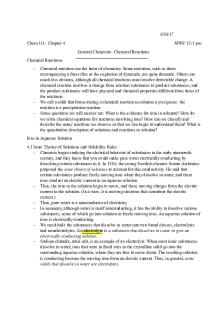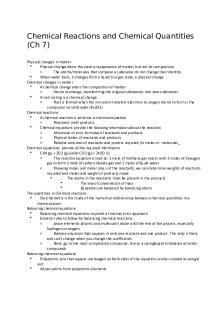Chem Quiz Review Quantities in Chemical Reactions PDF

| Title | Chem Quiz Review Quantities in Chemical Reactions |
|---|---|
| Course | Chemistry |
| Institution | High School - Canada |
| Pages | 3 |
| File Size | 111.7 KB |
| File Type | |
| Total Downloads | 119 |
| Total Views | 164 |
Summary
Notes...
Description
Chem Quiz Review: Quantities in Chemical Reactions ** To avoid “rounding error” you can carry an extra digit or two because you don’t want to compact the info if you need to do another calculation**
6.3 The Mole - A Unit of Counting What is a mole? - 1 mole = 6.02 x 1023 pieces or entities - 6.02 x 1023 is the number of atoms in exactly 12 g of C-12 ~ aka Avogadro's constant (NA) - discrete unit, large # b/c massive # of atoms/molecules in chemical rxns 6.4 Molar Mass Atomic mass vs molar mass - Atomic mass: the mass of an atom (in amu) - Molar mass: the mass of 1 mol of a substance (in g/mol) - Both are found on the periodic table with same numerical value n = m/M n = mols, m = mass in grams, M = molar mass in g/mol 6.5 Mass and Number of Entities N = n (NA) N = number of particles, n = mols, NA = (6.02 x 1023 entities*)/1 mol *molecules, atoms, particles, formula unit, etc. - molecules for molecular compound, formula units for ionic compound Number of Atoms Per Particle = N (# of atoms per particle) simply multiply number ‘N’ from previous calculation by number of atoms (i.e. if N in CaCl2 is 5.24 x 106 and you want to find number of chloride (Cl) atoms, multiply N by 2) 6.6 Determining % Composition of Compounds To solve from experimental data - Use fraction of samples - i.e. 500.00 mg sample of C9H8O4 contains 300.00 mg of carbon, and 8.08 mg of hydrogen. The remaining mass is oxygen. Determine % composition of compound. [ans. 60.000% carbon, 1.62 % hydrogen, 38.38% oxygen]
To solve from a chemical formula 1. Find molar mass of total compound
2. Find molar mass of each element 3. Make it a fraction Summary of Combustion Analysis (pg 284) - “burn and sniff” method to determine organic compound identity 1. Sample burned with enough O2 (to ensure complete combustion) 2. 2 successive chambers absorb CO2 and H2O resulting from complete combustion 3. Difference of mass before and after in chambers = mass of CO2 and H2O produced 4. Mass spectrometer determines molecular masses of compound Law of Definite Proportions: a compound always has the same proportion of elements by mass 6.7 Empirical Formulas Empirical formula - A formula that shows the simplest whole number ratio of elements in a compound Molecular formula - A formula that shows the exact number of each type of element in a compound To solve empirical formula or other related calculations 1. Based on % composition given, ‘assume’/use 100g as a reference point (so masses are easy to calculate) 2. Find molar mass of each element 3. Find number of moles for each element 4. Find simplest ratio by dividing the moles of each element by the smallest amount. 5. Multiply to the next largest whole number if there is a decimal *Any number within 0.05 of a whole number can be rounded 6.9 Molecular Formulas To solve from the givens of empirical formula and molecular molar mass: 1. Find empirical molar mass by adding the molar mass of each element 2. Find the ratio of the molar mass of the compound to the empirical formula: x=
molar mass of compound . molar mass of empirical formula
3. Multiply the subscripts of the empirical formula by the ratio found in step 2 To solve from % composition 1. Determine the amount/mass of each element in a 100.0g sample (use %) 2. Calculate the moles based on molar mass of each element (n = m/M)
3. 4. 5. 6.
Find simplest ratio by dividing the moles of each element by the smallest amount Multiply to the next largest whole number if there is a decimal Calculate the empirical molar mass based off of found ratios Find the ratio of the molar mass of the compound to the empirical formula: x=
molar mass of compound . molar mass of empirical formula
7. Multiply the subscripts of the empirical formula by the ratio found in step 6...
Similar Free PDFs

Chem 111 Ch 4 Chemical Reactions
- 17 Pages

Bill Nye Chemical Reactions
- 2 Pages

Rates of Chemical Reactions
- 9 Pages

Types of chemical reactions
- 4 Pages

Chapter 15 Chemical Reactions
- 21 Pages

Chemical reactions equations
- 6 Pages
Popular Institutions
- Tinajero National High School - Annex
- Politeknik Caltex Riau
- Yokohama City University
- SGT University
- University of Al-Qadisiyah
- Divine Word College of Vigan
- Techniek College Rotterdam
- Universidade de Santiago
- Universiti Teknologi MARA Cawangan Johor Kampus Pasir Gudang
- Poltekkes Kemenkes Yogyakarta
- Baguio City National High School
- Colegio san marcos
- preparatoria uno
- Centro de Bachillerato Tecnológico Industrial y de Servicios No. 107
- Dalian Maritime University
- Quang Trung Secondary School
- Colegio Tecnológico en Informática
- Corporación Regional de Educación Superior
- Grupo CEDVA
- Dar Al Uloom University
- Centro de Estudios Preuniversitarios de la Universidad Nacional de Ingeniería
- 上智大学
- Aakash International School, Nuna Majara
- San Felipe Neri Catholic School
- Kang Chiao International School - New Taipei City
- Misamis Occidental National High School
- Institución Educativa Escuela Normal Juan Ladrilleros
- Kolehiyo ng Pantukan
- Batanes State College
- Instituto Continental
- Sekolah Menengah Kejuruan Kesehatan Kaltara (Tarakan)
- Colegio de La Inmaculada Concepcion - Cebu









